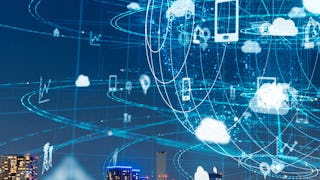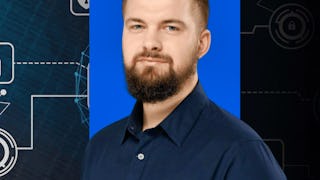Das explosive Wachstum des "Internet der Dinge" verändert unsere Welt und der rasante Preisverfall bei typischen IoT-Komponenten ermöglicht es den Menschen, neue Designs und Produkte zu Hause zu entwickeln. In diesem ersten Kurs der Spezialisierung lernen Sie die Bedeutung des IoT in der Gesellschaft, die aktuellen Komponenten typischer IoT-Geräte und Trends für die Zukunft kennen. Außerdem werden Überlegungen zum IoT-Design, Einschränkungen und Schnittstellen zwischen der physischen Welt und Ihrem Gerät behandelt. Sie werden auch lernen, wie Sie beim Design Kompromisse zwischen Hardware und Software eingehen können. Wir werden auch die wichtigsten Komponenten der Vernetzung behandeln, damit die Teilnehmer wissen, wie sie ihr Gerät mit dem Internet verbinden können. Bitte beachten Sie, dass dieser Kurs keine Diskussionsforen beinhaltet. Nach Abschluss dieses Kurses werden Sie in der Lage sein: 1. Definieren Sie den Begriff "Internet der Dinge" 2. Nennen Sie die technologischen Trends, die zum IoT geführt haben 3. Beschreiben Sie die Auswirkungen des IoT auf die Gesellschaft 4. Definieren Sie, was ein eingebettetes System in Bezug auf seine Schnittstelle ist 5. Nennen und beschreiben Sie die Komponenten eines eingebetteten Systems 6. Beschreiben Sie die Interaktionen von eingebetteten Systemen mit der physischen Welt 7. Nennen Sie die wichtigsten Hardwarekomponenten, die am häufigsten in IoT-Geräten verwendet werden 8. Beschreiben Sie die Interaktion zwischen Software und Hardware in einem IoT-Gerät 9. Beschreiben Sie die Rolle eines Betriebssystems zur Unterstützung der Software in einem IoT-Gerät 10. Erklären Sie die Verwendung von Netzwerken und grundlegender Netzwerkhardware 11. Beschreiben Sie die Struktur des Internets 12. Beschreiben Sie die Bedeutung eines "Netzwerkprotokolls" 13. Erklären Sie MANETs und ihre Beziehung zum IoT



Einführung in das Internet der Dinge und eingebettete Systeme
Dieser Kurs ist Teil von Spezialisierung Eine Einführung in die Programmierung des Internets der Dinge (IOT)

Dozent: Ian Harris
343.502 bereits angemeldet
Bei  enthalten
enthalten
(13,295 Bewertungen)
Kompetenzen, die Sie erwerben
- Kategorie: Computer-Vernetzung
- Kategorie: Betriebssysteme
- Kategorie: Kommunikation
- Kategorie: Computerprogrammierung
- Kategorie: Mensch-Computer-Interaktion
Wichtige Details

Zu Ihrem LinkedIn-Profil hinzufügen
4 Aufgaben
Erfahren Sie, wie Mitarbeiter führender Unternehmen gefragte Kompetenzen erwerben.

Erweitern Sie Ihre Fachkenntnisse
- Lernen Sie neue Konzepte von Branchenexperten
- Gewinnen Sie ein Grundverständnis bestimmter Themen oder Tools
- Erwerben Sie berufsrelevante Kompetenzen durch praktische Projekte
- Erwerben Sie ein Berufszertifikat zur Vorlage


Erwerben Sie ein Karrierezertifikat.
Fügen Sie diese Qualifikation zur Ihrem LinkedIn-Profil oder Ihrem Lebenslauf hinzu.
Teilen Sie es in den sozialen Medien und in Ihrer Leistungsbeurteilung.

In diesem Kurs gibt es 4 Module
Das Internet der Dinge (IoT) ist derzeit ein beliebtes Schlagwort. Doch im Gegensatz zu vielen Modeerscheinungen, die kommen und gehen, beschreibt das Internet der Dinge einen wichtigen Trend, der nachhaltige Auswirkungen auf die Gesellschaft insgesamt hat. Der Begriff selbst, "Internet der Dinge", wird je nach Motivation und Hintergrund des Sprechers für eine Vielzahl von Ideen verwendet. In diesem Kurs werden wir zunächst eine Definition des Begriffs geben. Wir werden darüber sprechen, wie verschiedene Trends das Internet der Dinge ermöglicht haben und wie es die Art und Weise, wie Design betrieben wird, verändert. Wir werden auch einige der Auswirkungen diskutieren, die das IoT auf die heutige Gesellschaft hat.
Das ist alles enthalten
10 Videos4 Lektüren1 Aufgabe1 peer review
In Modul 1 haben wir das Konzept des Internets der Dinge auf einer hohen Ebene eingeführt, indem wir den Begriff definiert und seine Implikationen umrissen haben. In diesem Modul untersuchen wir einige der Details, die mit dem Design und der Implementierung von IoT-Geräten verbunden sind. Im Gegensatz zu herkömmlichen computergestützten Systemen sind IoT-Geräte in andere Geräte "eingebettet", um eine erweiterte Funktionalität zu bieten, ohne dass der Benutzer mit der Komplexität eines Computers konfrontiert wird. Die Benutzer interagieren mit dem Gerät auf natürliche Weise, ähnlich wie mit jedem anderen Objekt in der Welt. Auf diese Weise verfügt ein eingebettetes System über eine Schnittstelle, die den Erwartungen und Bedürfnissen der Benutzer entspricht. Um eine natürliche Schnittstelle zu schaffen, muss das eingebettete System über Sensoren, die den Zustand der Welt erfassen, und Aktoren, die den Zustand der Welt verändern, direkt mit der physischen Welt interagieren. In diesem Modul werden wir die Struktur von eingebetteten Systemen erörtern und diese Interaktionen mit der physischen Welt beschreiben.
Das ist alles enthalten
9 Videos2 Lektüren1 Aufgabe1 peer review
IoT-Geräte werden sowohl mit Hardware- als auch mit Softwarekomponenten implementiert. Dedizierte Hardwarekomponenten werden verwendet, um die Schnittstelle zur physischen Welt zu implementieren und rechenintensivere Aufgaben auszuführen. Mikrocontroller werden verwendet, um Software auszuführen, die Eingaben interpretiert und das System steuert. In diesem Modul wird die Rolle der Hardware- und Softwarekomponenten im System erörtert. Es werden die Funktionen gängiger Hardwarekomponenten beschrieben und die Schnittstelle zwischen Software und Hardware über den Mikrocontroller erläutert. IoT-Geräte verwenden häufig ein Betriebssystem, um die Interaktion zwischen der Software und dem Mikrocontroller zu unterstützen. Wir werden definieren, welche Rolle ein Betriebssystem in einem IoT-Gerät spielt und wie sich ein IoT-Betriebssystem von einem Standard-Betriebssystem unterscheidet.
Das ist alles enthalten
9 Videos2 Lektüren1 Aufgabe1 peer review
Ein wichtiger Aspekt des Internets der Dinge ist, dass die Geräte auf irgendeine Weise vernetzt und oft mit dem Internet verbunden sind. Die Vernetzung ermöglicht es den Geräten, mit anderen IoT-Geräten und größeren cloudbasierten Servern zu kommunizieren. IoT-Geräte können oft als kleine Teile eines viel größeren kollektiven Systems betrachtet werden, zu dem auch große Server in der Cloud gehören. In diesem Modul werden die Grundlagen der Vernetzung und insbesondere des Internetprotokolls vorgestellt. Schließlich sind die meisten IoT-Geräte mit dem Internet verbunden, so dass das Verständnis der mit dem Internet verbundenen Protokolle wichtig für die Entwicklung von IoT-Geräten ist. Wir werden auch das Konzept eines mobilen Ad-hoc-Netzwerks (MANET) vorstellen, das kleine, lokale Netzwerke von IoT-Geräten beschreibt.
Das ist alles enthalten
10 Videos3 Lektüren1 Aufgabe1 peer review
Dozent

Mehr von Softwareentwicklung entdecken

IIT Bombay

EIT Digital

Kennesaw State University
Warum entscheiden sich Menschen für Coursera für ihre Karriere?




Bewertungen von Lernenden
13.295 Bewertungen
- 5 stars
74,30 %
- 4 stars
21,54 %
- 3 stars
2,73 %
- 2 stars
0,66 %
- 1 star
0,75 %
Zeigt 3 von 13295 an
Geprüft am 26. Nov. 2017
Great class! Overall, it covers mostly the basics of Internet of Things. Good for those who are new to the field. Would not recommend it to those who have some knowledge on embedded systems already.
Geprüft am 8. Nov. 2019
The course covers the basics of the Terms which are used in IoT systems and introduces you to some networking terms. Not a lot of hands-on stuff. Expecting a lot of stuff in the upcoming courses.
Geprüft am 14. Juli 2020
Please Review my Assignment!! I don't want my subscription to end!https://www.coursera.org/learn/iot/peer/qYW91/module-1-peer-review-identify-and-analyze-a-device/review/QVfqbMbxEeqwjxJtwcpIbQ

Neue Karrieremöglichkeiten mit Coursera Plus
Unbegrenzter Zugang zu 10,000+ Weltklasse-Kursen, praktischen Projekten und berufsqualifizierenden Zertifikatsprogrammen - alles in Ihrem Abonnement enthalten
Bringen Sie Ihre Karriere mit einem Online-Abschluss voran.
Erwerben Sie einen Abschluss von erstklassigen Universitäten – 100 % online
Schließen Sie sich mehr als 3.400 Unternehmen in aller Welt an, die sich für Coursera for Business entschieden haben.
Schulen Sie Ihre Mitarbeiter*innen, um sich in der digitalen Wirtschaft zu behaupten.
Häufig gestellte Fragen
Der Zugang zu Vorlesungen und Aufgaben hängt von der Art Ihrer Einschreibung ab. Wenn Sie einen Kurs im Prüfungsmodus belegen, können Sie die meisten Kursmaterialien kostenlos einsehen. Um auf benotete Aufgaben zuzugreifen und ein Zertifikat zu erwerben, müssen Sie die Zertifikatserfahrung während oder nach Ihrer Prüfung erwerben. Wenn Sie die Prüfungsoption nicht sehen:
Der Kurs bietet möglicherweise keine Prüfungsoption. Sie können stattdessen eine kostenlose Testversion ausprobieren oder finanzielle Unterstützung beantragen.
Der Kurs bietet möglicherweise stattdessen die Option 'Vollständiger Kurs, kein Zertifikat'. Mit dieser Option können Sie alle Kursmaterialien einsehen, die erforderlichen Bewertungen abgeben und eine Abschlussnote erhalten. Dies bedeutet auch, dass Sie kein Zertifikat erwerben können.
Wenn Sie sich für den Kurs einschreiben, erhalten Sie Zugang zu allen Kursen der Specializations, und Sie erhalten ein Zertifikat, wenn Sie die Arbeit abgeschlossen haben. Ihr elektronisches Zertifikat wird Ihrer Erfolgsseite hinzugefügt - von dort aus können Sie Ihr Zertifikat ausdrucken oder zu Ihrem LinkedIn-Profil hinzufügen. Wenn Sie die Kursinhalte nur lesen und ansehen möchten, können Sie den Kurs kostenlos besuchen.
Wenn Sie ein Abonnement abgeschlossen haben, erhalten Sie eine kostenlose 7-tägige Testphase, in der Sie kostenlos kündigen können. Danach gewähren wir keine Rückerstattung, aber Sie können Ihr Abonnement jederzeit kündigen. Siehe unsere vollständigen Rückerstattungsbedingungen.
Weitere Fragen
Finanzielle Unterstützung verfügbar,


